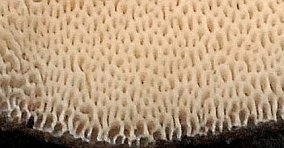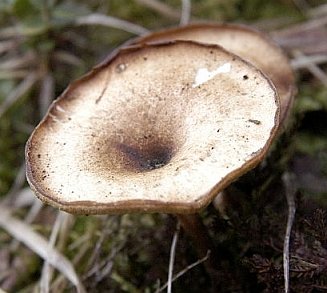The winter polypore, Polypore brumalis (Pers.) Fr.
Synonyms
Boletus brumalis Pers.
Boletus ciliatus Hornem.
Boletus fasciculatus Schrad.
Boletus fuscidulus Schrad.
Boletus hypocrateriformis Schrank
Boletus umbilicatus Schrank
Favolus apiahynus Speg.
Leucoporus brumalis (Pers.) Sacc., in Trotter
Leucoporus brumalis (Pers.) Speg.
Leucoporus vernalis (Fr.) Pat.
Microporus substriatus (Rostk.) Kuntze
Polyporellus brumalis (Pers.) P. Karst.
Polyporellus fuscidulus (Schrad.) P. Karst.
Polyporus brumalis f. subarcularius Donk
Polyporus cyathoides Quél.
Polyporus fuscidulus (Schrad.) Fr.
Polyporus luridus Berk. & M.A. Curtis
Polyporus nanus F. Brig.
Polyporus pauperculus Speg.
Polyporus subarcularius (Donk) Bondartsev
Polyporus substriatus Rostk.
Polyporus trachypus Rostk.
Polyporus tucumanensis Speg.
Polystictus substriatus (Rostk.) Cooke
Common names
Winter polypore

My name is Austin Collins.
I've dedicated my life to Mushrooms.
I believe Mushrooms are the best kept secret when it comes to health and well being.
For that reason, I would like to share a company with you that in my opinion makes the best mushroom products on the market.
The company is called Noomadic Herbals, my favorite supplement they make is called "Mushroom Total".
I take their products every day and they have helped me think better and have more energy. Give them a try.
-Austin
Description
Cap: 2-8 cm diameter; upper surface greyish-brown, sometimes faintly zonate, convex with shallow central depression, smooth, wavy often inrolled margin.
Stem: 2-6 cm high x 0.3-1 cm width; pallid, tawny, central, equal, often curved.
Flesh: whitish and leathery.
Pores: whitish cream or pallid buff, circular, elongating with age, 2-3 per mm. Tubes whitish, becoming cream, decurrent, 0.5-2 mm deep.

Spores: 6-8 x 2-3 µm, smooth, hyaline, cylindrical or allantoid, non-amyloid.
Odor and taste: not distinctive.
(Description adapted from Jordan, 2004, p. 102.)
As Jordan notes, this inedible species can be distinguished from the similar-looking Polyporus ciliatus by the size of its pores (P. ciliatus has 4-6 pores per mm).
Interestingly, Polyporus brumalis has been used as a model system in a number of studies to investigate the effect of a zero-gravity environment on fungal growth (Moore, 1991; Kasatkina et al., 1980; Vaulina et al., 1979; Zharikova et al., 1977)
Medicinal effects
Anti-tumor properties
An extract of culture mycelia was able to inhibit the growth of Sarcoma 180 solid cancer in mice by 90% (Ohtsuka et al., 1973).
Using the streak-plate method (a test for antibacterial activity), this species did not inhibit the growth of Staphylococcus aureus nor Escherichia coli on either thiamine peptone medium or malt agar (Robbins et al., 1945)
Links
Josef Hlasek’s website
Fungi on Wood website
This patent outlines a method for producing P. brunalis as a mycelial culture.
References
Moore D.
Perception and response to gravity in higher fungi–a critical appraisal.
New Phytol. 1991 117:3-23. Review.
Pubmed
Jordan M. 2004.
The Encyclopedia of Fungi of Britain and Europe.
Frances Lincoln Ltd. 384 pp.
Google Book preview
Kasatkina TB, Zharikova GG, Rubin AB, Palmbakh LR, Vaulina EN, Mashinsky AL.
Development of higher fungi under weightlessness.
Life Sci Space Res. 1980 18:205-11.
Pubmed
Ohtsuka S, Ueno S, Yoshikumi C, Hirose F, Ohmura Y, Wada T, Fujii T, Takahashi E.
Polysaccharides having an anticarcinogenic effect and a method of producing them from species of Basidiomycetes.
UK Patent 1331513, 26 September 1973.
Robbins WJ, Hervey A, Davidson RW, Ma R, Robbins WC.
A survey of some wood-destroying and other fungi for antibacterial activity.
Bull Torr Bot Club. 1945 72(2):165-190.
Vaulina EN, Palmbakh LR, Antipov VV, Anikeeva ID, Kostina LN, Zharikova GG, Kasatkina TB.
Biological investigations on the orbital station “Salyut-5”.
Life Sci Space Res. 1979 17:241-6.
Pubmed
Zharikova GG, Rubin AB, Nemchinov AV.
Effects of weightlessness, space orientation and light on geotropism and the formation of fruit bodies in higher fungi.
Life Sci Space Res. 1977 15:291-4.
Pubmed



